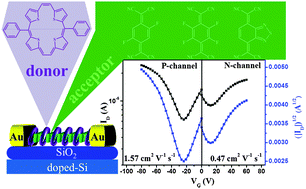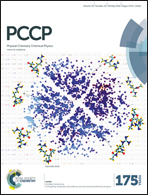Efficient ambipolar transport properties in alternate stacking donor–acceptor complexes: from experiment to theory†
Abstract
Comprehensive investigations of crystal structures, electrical transport properties and theoretical simulations have been performed over a series of sulfur-bridged annulene-based donor–acceptor complexes with an alternate stacking motif. A remarkably high mobility, up to 1.57 cm2 V−1 s−1 for holes and 0.47 cm2 V−1 s−1 for electrons, was obtained using organic single crystal field-effect transistor devices, demonstrating the efficient ambipolar transport properties. These ambipolar properties arise from the fact that the electronic couplings for both holes and electrons have the same super-exchange nature along the alternate stacking direction. The magnitude of super-exchange coupling depends not only on the intermolecular stacking distance and pattern, but also the energy level alignments between the adjacent donor–acceptor moieties. The concluded transport mechanism and structure–property relationship from this research will provide an important guideline for the future design of organic semiconductors based on donor–acceptor complexes.


 Please wait while we load your content...
Please wait while we load your content...